Wildcats
by John Robinson
In the early days of metallic cartridges, almost all cartridges could have been classed as wildcats, as someone had to come up with a cartridge that was not in existence before. However, the development of wildcat cartridges really began in the 1920s when experimenters started
 Over time, many of these wildcat cartridges developed before 1950 have
been tamed and have long been commercialised. Cartridges such as the
.22 Hornet, .22-250, .257 Roberts, .25-06 and many others all started
their life as an experiment.
Over time, many of these wildcat cartridges developed before 1950 have
been tamed and have long been commercialised. Cartridges such as the
.22 Hornet, .22-250, .257 Roberts, .25-06 and many others all started
their life as an experiment.
There are still many wildcat cartridges that have been thought up by some keen experimenter, and in the big game cartridges in particular, some of these are on the fringes of being commercial, with ammo being produced in small quantities by specialist manufacturers.
There remains one area where almost all the cartridges used are wildcats and none have been commercialised and that is in the sport of Handgun Metallic Silhouette competition. This has been the most prolific breeding ground for wildcat cartridges and in most cases, the wildcat development have no commercial equivalents that deliver the same performance. This is not the case for most long-arm wildcat cartridges whose performance is rarely far away from their factory-loaded alternatives.
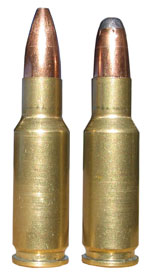 The need for specialised cartridges for big bore IHMSA competition has
arisen from the need to have cartridges with enough knock-down power to
deal with heavy steel ram targets at 200 metres, along with a high
degree of accuracy, out of barrels that have a maximum allowable length of 355mm.
The need for specialised cartridges for big bore IHMSA competition has
arisen from the need to have cartridges with enough knock-down power to
deal with heavy steel ram targets at 200 metres, along with a high
degree of accuracy, out of barrels that have a maximum allowable length of 355mm.
There are three basic courses of fire to consider with big bore silhouette. The main event is shot out to 200 metres on full-sized targets. Because many shooters were shooting perfect scores a Half-Size match was introduced.
This is shot over the same distance, except the targets are, as the name suggests, half-size. This really means they are a quarter of the area of the full-size targets as they are half-size in both directions. This increases the degree of difficulty significantly, but the reduced weight of the targets means that lighter bullets can be used.
The Field Pistol match is shot over 100 metres and parallel-sided cased cartridges must be used that are no longer than a .357 Magnum cartridge.
While many of the wildcats developed for IHMSA competition have not gained much of a following, many others have become almost universally popular, although few commercial firearms are chambered for any of them.
One of the smallest silhouette wildcats is the .270 REN. This cartridge was specifically developed for the 100-metre Field Pistol match, where parallel-sided cases are specified, although the .22 Hornet and .32-20 get an exemption as they are deemed to be close enough to that specification.
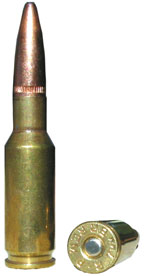 The cartridge is simply a .22 Hornet case blown out to be parallel,
which gives it its .270 calibre. It is a very efficient little
cartridge and can launch a 100-grain bullet at around 500 m/sec
(1600fps) with low recoil and little muzzle blast out of a 250mm
barrel.
The cartridge is simply a .22 Hornet case blown out to be parallel,
which gives it its .270 calibre. It is a very efficient little
cartridge and can launch a 100-grain bullet at around 500 m/sec
(1600fps) with low recoil and little muzzle blast out of a 250mm
barrel.
Thompson Contender has barrels available from its custom shop in this chambering and several silhouette shooters in my club have TC barrels chambered for the .270 REN.
The 6mm calibres have never gained much of a following with Australian silhouette shooters, as the bullet weights are too light for other than the Half-Size match. However, the 6mm TCU, which is a .223 Remington sized up to 6mm, and the 6mm BR Remington, have both seen limited service for Silhouette.
Remington’s XP100 bolt-action pistol has been the basis for many unlimited silhouette pistols, and has been factory-chambered for the 6mm BR. Remington also produced brass in 6mm BR. Cases can be made from .308 brass, but really need brass with a small primer pocket to meet the original specifications.
The 7mm wildcats have been very popular for many years, as the 7mm offers a wide range of bullet weights, very good accuracy and moderate recoil for the power of the cartridges being used.
The 7mm TCU has been a universal favourite; I have two barrels for my Thompson Contender in this calibre (250mm and 355mm). With 140-grain bullets, velocities around 500 metres per second are easily obtained from the 250mm barrel. This shoots quite flat out to 200 metres, requiring only a few clicks of elevation at each range to stay on target out to 200 metres.
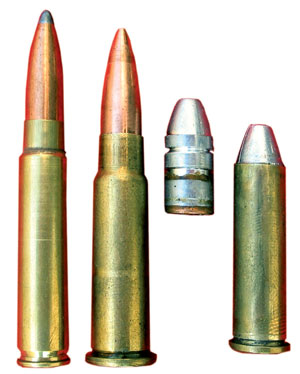 The cases are very easy to form from .223 brass. New commercial brass
works best. In a rifle-length barrel, with 100-grain bullets, the 7mm
TCU is not far behind a 7x57 Mauser in performance.
The cases are very easy to form from .223 brass. New commercial brass
works best. In a rifle-length barrel, with 100-grain bullets, the 7mm
TCU is not far behind a 7x57 Mauser in performance.
The 7mm BR Remington is a very popular choice for unlimited bolt-action pistols in silhouette. It is the same basic case as the 6mm BR. It is not strictly a wildcat, as Remington factory cases are reported to be available, although the firearms themselves usually need to be made up to shooters’ specifications.
The 7mm International Rimmed has also had a following. It is a 30-30 Winchester necked down to 7mm, although some wildcatters prefer to make the cases from much more expensive and hard to get 375 Winchester brass.
The 7mm IR has a larger case than the 7mm TCU and thus has more punch. The rimmed case also works better in single-shot break-action pistols. There is also a 7mm IHMSA cartridge that is based on a .308 Winchester or .300 Savage case. This has about the same case capacity as the 7mm International Rimmed but is in a rimless case. For some reason, the 7x30 Waters has not displaced some of these very similar 7mm cartridges. The 7x30 was originally designed by Ken Waters for the Model 94 Winchester, and is a commercial cartridge, although rarely seen in this part of the world.
A somewhat strange wildcat has emerged as one of the smallest .30-calibre offerings: the .300 Whisper. It is about as far as the .223 case can be blown out. Like all the .223-based wildcats, it is a very efficient performer and can launch 130- to 140-grain bullets at about 600 metres per second out of a pistol-length barrel. Thompson Contender has chambered its barrels in this calibre and it has been seen on the firing line at silhouette matches.
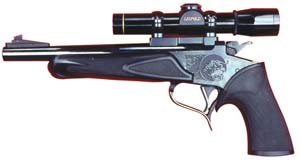 The .30 BR Remington is another one of the same family of cartridges
that is formed from the Remington bench rest brass. It has been around
for a while and usually turns up in XP100 Remington custom Unlimited
pistols.
The .30 BR Remington is another one of the same family of cartridges
that is formed from the Remington bench rest brass. It has been around
for a while and usually turns up in XP100 Remington custom Unlimited
pistols.
The .30 Herrett is one of the oldest silhouette wildcats and I have been shooting one of these almost since silhouette shooting started in Australia in the 1980s. It was originally developed by Steve Herrett and Bob Milek, now both in the great hunting ground in the sky.
They pioneered the idea that the Thompson Contender could deliver a lot more performance than even its designers thought, and designed several cartridges to optimise performance out of the Contender barrels. These were originally intended for hunting.
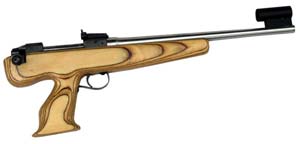 The .30 Herrett is a .30-30 case with the shoulder pushed back and the
length trimmed to 40mm. It is a very efficient cartridge and the rimmed
case works well in the TC. While the cases are a bit of a fiddle to
make, case life is long and the .30 Herrett is not far behind the
full-size .30-30 Winchester out of a pistol-length barrel.
The .30 Herrett is a .30-30 case with the shoulder pushed back and the
length trimmed to 40mm. It is a very efficient cartridge and the rimmed
case works well in the TC. While the cases are a bit of a fiddle to
make, case life is long and the .30 Herrett is not far behind the
full-size .30-30 Winchester out of a pistol-length barrel.
While some silhouette shooters have experimented with larger calibres, most have been commercial offerings like the .35 Remington, which while no longer chambered commercially in long arms, have found a home in Thompson Contender pistols used for silhouette.
Recoil puts people off these heavier cartridges. Bullet weight has a lot to do with it - more so than velocity. The only wildcat in this category is another Herrett development - .357 Herrett. This is again formed from .30-30 brass, necked up to .357 and trimmed to about 45mm.
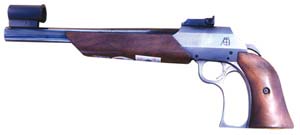 It is a powerful cartridge and can deliver 180-grain bullets at nearly
700 metres/second. You know it is going off. I have had a couple of TCs
in this calibre and found it too much gun for competition work; it
would be better suited to hunting should that pastime be legal in this
country.
It is a powerful cartridge and can deliver 180-grain bullets at nearly
700 metres/second. You know it is going off. I have had a couple of TCs
in this calibre and found it too much gun for competition work; it
would be better suited to hunting should that pastime be legal in this
country.
It has been a while now since any new wildcats have appeared on silhouette ranges around Australia, as most of the gaps appear to have been filled and the current crop of cartridges has not left anything to be desired in performance.
The 7mm wildcats seem to be the most popular, but some shooters prefer the .30 calibre with heavier loads to get more reliable knock-down. Occasional refusals occur with lighter bullets and if a good hit on a ram does not knock it over, that is too bad.
